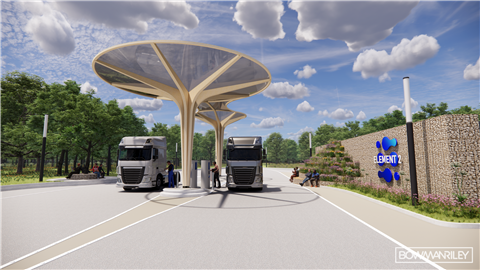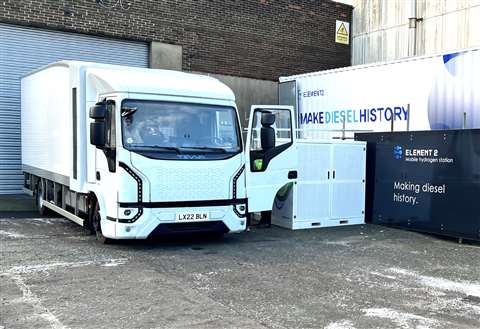Element 2 plans UK network of hydrogen fuel stations
02 March 2023
 Artist’s impression of Element 2 hydrogen refuelling station (Photo: Element 2)
Artist’s impression of Element 2 hydrogen refuelling station (Photo: Element 2)
A series of companies, ranging in size from startups to global OEMs, are involved in the development and launch of vehicles using hydrogen fuel cells. These convert hydrogen into the electricity needed to drive the powertrain and ancillary equipment.
Advances in fuel cell technology have made the power source increasingly attractive as an alternative to diesel internal combustion, with largely equivalent ranges and refuelling times. Yet the problem up until now has been sourcing the fuel. While there are a limited number of locations now offering hydrogen for fuel, they a generally located in and around larger cities.
UK-based Element 2 has plans to rectify this situation. From around mid-2023, the company is planning to have five hydrogen retailing sites open for business around the UK. But this is only the start, as a further 30 locations are anticipated to be ‘operational or under construction’ by the end of the year.
In an interview with UK-based motoring magazine Autocar, Brendan Bilton, chief technology officer at Element 2, said: “[At that point] we should be able to say to fleet operators that we have a national network with about 100 miles between stops, which in a vehicle with a range of between 300 and 400 miles isn’t a problem logistically.”
As the range of most hydrogen-fuelled vehicles falls between these figures – trucks and buses will have proportionally longer single-fill ranges - the 100-mile distance between locations should support a model similar to petrol forecourts.
 Tevva fuel cell truck refuelling at Element 2 site (Photo: Tevva)
Tevva fuel cell truck refuelling at Element 2 site (Photo: Tevva)
In January this year a 7.5-tonne FCEV produced by the CV startup Tevva completed a return journey from London to Berwick-on-Tweed, a return journey of 620 miles. One of the two refuelling stops was completed at a site in Middlesborough operated by Element 2.
Many similar plans have focused on serving the passenger vehicle market. But the initial target of the Element 2 locations is commercial vehicles, including trucks and buses.
This is largely due to anticipated fuel usage and related turnover. Where a passenger vehicle uses about 1 kg of hydrogen fuel per day, a bus will use about 20 kg. A truck could use up to 50 kg. It is these larger numbers which will deliver the revenue needed to support the business model.
“We worked out early on [that] you can make good money out of this as long as you have enough hydrogen going through your pumps,” says Bilton.
The fuel distributor is anticipating that the ban on new-car sales with internal combustion engines due in 2030 will create more interest in the hydrogen fuel vehicles. Although the locations will be developed with CV refuelling in mind, passenger cars will also be able to refuel at the sites.
STAY CONNECTED




Receive the information you need when you need it through our world-leading magazines, newsletters and daily briefings.
POWER SOURCING GUIDE
The trusted reference and buyer’s guide for 83 years
The original “desktop search engine,” guiding nearly 10,000 users in more than 90 countries it is the primary reference for specifications and details on all the components that go into engine systems.
Visit Now
CONNECT WITH THE TEAM










